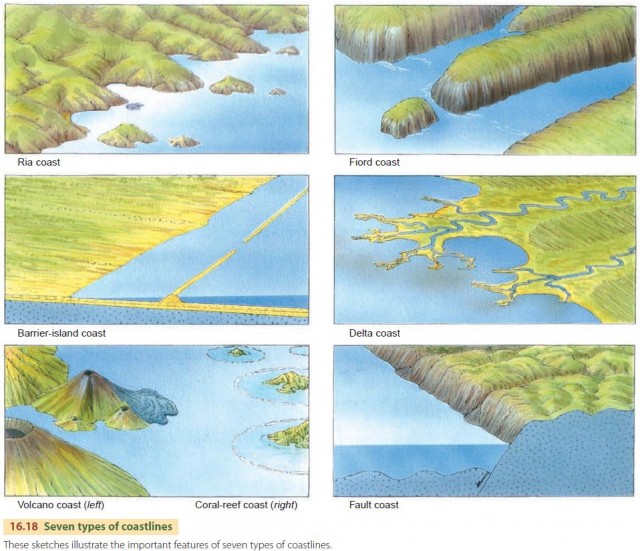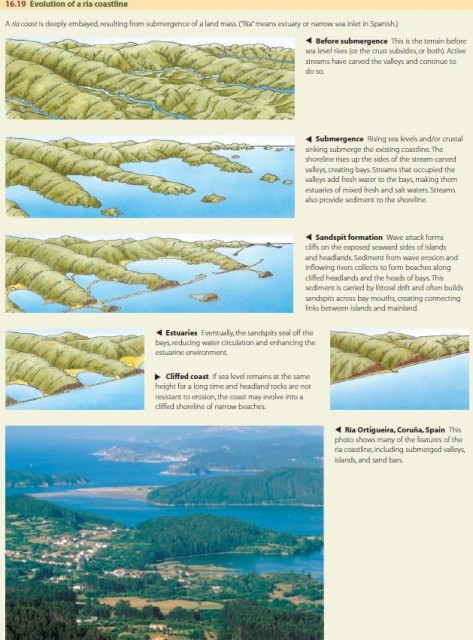Types of Coastlines
Although every coastline is a unique creation of ocean waves acting on distinctive land masses, we can identify seven important types of coasts, shown in Figure 16.18. Coastlines of submergence are formed when the rising sea level partially drowns a coast or when part of the crust sinks. This group includes ria coasts and fiord coasts.
Another group of coastlines are formed by the process of emergence, when submarine landforms are exposed by a falling of sea level or a rising of the crust. This group includes barrier-island coasts, volcano coasts, delta coasts, fault coasts, and coral-reef coasts.

RIA COASTS AND FIORD COASTS
Coastlines of submergence include ria coasts and fiord coasts. A ria coast is formed when a rise of sea level or a crustal sinking (or both) brings the shoreline to rest against the sides of river valleys previously carved by streams. Because the new embayments are fed fresh water from the streams the valleys formerly contained, they become estuaries. Figure 16.19 describes the formation of a ria coast in more detail.
The fiord coast is similar to the ria coast. Steep-walled fiords are created from submerged glacial troughs rather than from submerged stream valleys, as in the case of ria coasts.

BARRIER-ISLAND COASTS
The barrier-island coast is associated with a recently emerged coastal plain. A barrier island is a low ridge of sand, lying a short distance from the coast, that is created by wave action and increases in height as coastal winds fortify the island with dunes. Much of the Atlantic and Gulf coast from New York to Texas is flanked by barrier islands.
Behind the barrier island is a lagoon—a broad expanse of shallow water in places largely filled with tidal deposits. Characteristic gaps, known as tidal inlets, along the barrier island connect the lagoon with the ocean.
Strong currents flow back and forth through these gaps as the tide rises and falls. New inlets are formed in severe storms and are then kept open by the tidal currents. In many cases, these inlets are later closed by littoral drift.
DELTA COASTS
The deposit of clay, silt, and sand made by a stream or river where it flows into a body of standing water is known as a delta (Figure 16.22). The sediment is deposited because the current is rapidly slowed as it pushes out into the standing water. The river channel divides and subdivides into lesser channels called distributaries. The coarser sand and silt particles settle out first, while the fine clays continue out farthest and eventually come to rest in fairly deep water. When the fine clay particles in fresh water come into contact with salt water, they clot together into larger particles that settle to the seafloor.
Deltas can grow rapidly, at rates ranging from 3 m (about 10 ft) per year for the Nile Delta to 60 m (about 200 ft) per year for the Mississippi Delta. Some cities and towns that were at river mouths several hundred years ago are today several kilometers inland.

VOLCANO AND CORAL-REEF COASTS
Volcano coasts arise where volcanic deposits—lava and ash—flow from active volcanoes into the ocean. Wave action erodes the fresh deposits, creating low cliffs. Beaches are typically narrow, steep, and composed of fine particles of the extrusive rock. Coral-reef coasts are unique because the new land is made by organisms—corals and algae. Growing together, these organisms secrete rock-like deposits of carbonate minerals, called coral reefs. As coral colonies die, new ones are built on them, accumulating as limestone.
Coral fragments are torn free by wave attack, and the pulverized fragments accumulate as sand beaches. We find coral-reef coasts in warm tropical and equatorial waters between lat. 30° N and 25° S. This is because water temperatures above 20°C (68°F) are needed for dense coral reefs to grow. Reef corals live near the water surface. The sea water must be free of suspended sediment, and it must be well aerated for vigorous coral growth to take place. For this reason, corals thrive in positions exposed to wave attack from the open sea. Because muddy water prevents coral growth, coral reefs are absent at the mouths of muddy streams. Coral reefs are remarkably flat on top. They are exposed at low tide and covered at high tide. As noted earlier, some coral reefs have been damaged by increased ocean temperatures and water pollution.
There are three distinctive types of coral reefs—fringing reefs, barrier reefs, and atolls. Fringing reefs are built as platforms attached to shore. They are widest in front of headlands where the wave attack is strongest. Barrier reefs lie out from shore and are separated from the mainland by a lagoon. There are narrow gaps at intervals along barrier reefs, through which excess water from breaking waves is returned from the lagoon to the open sea.
Atolls are more or less circular coral reefs enclosing a lagoon but have no land inside. Most atolls are rings of coral growing on top of old, sunken volcanoes. They begin as fringe reefs surrounding a volcanic island, then, as the volcano sinks, the reef continues to grow, and eventually only the reef remains.
FAULT COASTS
The final type of coastline is a fault coast. Faulting of the coastal margin of a continent can leave the shoreline resting against a fault scarp. A classic example occurs on the northern coast of Chile, where the Andes Mountains rise from the Peru–Chile trench. In central California, near the coastal town of Lucia, the continental shelf is very narrow, suggesting that the marine cliffs there are the result of faulting.
RAISED SHORELINES AND MARINE TERRACES
The active life of a shoreline is sometimes cut short by a drop in sea level. When this happens, a raised shoreline results. Wave erosion stops and an abrasion platform, now above sea level, will become a marine terrace. As we will see in Chapter 17, sea level remains relatively stable during interglacial periods and then falls hundreds of meters as the Earth's water is locked up in continental glaciers.
If we superimpose episodes of rising and falling sea level on a coastline that is slowly being raised by tectonic activity, a series of raised shorelines is created, including sequences of marine terraces. Raised shorelines are common along the continental and island coasts of the Pacific Ocean. Here tectonic processes are active along mountain and island arcs.